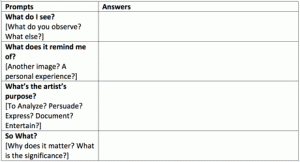Common Core in Action: 10 Visual Literacy Strategies
Your content has been saved!
Go to My Saved Content.Do you wish your students could better understand and critique the images that saturate their waking life? That’s the purpose of visual literacy (VL)—to explicitly teach a collection of competencies that will help students think through, think about, and think with pictures.
Standards Support Visual Literacy Instruction
Visual literacy is a staple of 21st century skills, the idea that learners today must “demonstrate the ability to interpret, recognize, appreciate, and understand information presented through visible actions, objects, and symbols, natural or man-made.” Putting aside the imperative to teach students how to create meaningful images, the ability to read images is reflected in the following standards.
Common Core State Standards
- CCSS.ELA-Literacy.RH.6-8.7: “Integrate visual information (e.g., in charts, graphs, photographs, videos, or maps) with other information in print and digital texts.”
- CCSS.ELA-Literacy.CCRA.R.7: “Integrate and evaluate content presented in diverse media and formats, including visually and quantitatively, as well as in words.”
- CCSS.ELA-Literacy.CCRA.R.6: “Assess how point of view or purpose shapes the content and style of a text.”
- CCSS.ELA-Literacy.CCRA.SL.1: “Prepare for and participate effectively in a range of conversations and collaborations with diverse partners, building on others’ ideas and expressing their own clearly and persuasively.”
National Council of Teachers of English Standards
- Standard 1: Students read a wide range of print and non-print texts.
Mid-Continent Research for Education and Learning Standards
- Standard 9: Uses viewing skills and strategies to interpret visual media.
On their own and without explicit, intentional, and systematic instruction, students will not develop VL skills because the language for talking about images is so foreign. Ever heard kids debate the object salience and shot angles of a Ryan Gosling meme? To add to the instructional complexity, visuals come in an assortment of formats, including advertisements, cartoons (including political cartoons), charts and graphs, collages, comic books and graphic novels, diagrams and tables, dioramas, maps, memes, multimodal texts, photos, pictograms, signs, slide shows, storyboards, symbols, timelines, videos.
How to Teach Visual Literacy: Visual Thinking Routines
The VL strategies described in the sections that follow are simple to execute, but powerfully effective in helping students interpret images.
Think-alouds: The think-aloud strategy—typically used to model how adept readers make meaning from a text (demonstrated in the following short video)—can be adapted for reading a visual artifact. After you model how to do it, have learners try this approach with a partner. Encourage elaborate responses. If you need a crash course in visual grammar before implementing this strategy in class, build your background knowledge with Discovering How Images Communicate.
Model Think-Aloud strategy from Derek Fernandez on Vimeo.
Visual Thinking Strategies: Visual Thinking Strategies (VTS) is a specific approach to whole-class viewing and talking about art that primarily uses these questions:
- What do you notice?
- What do you see that makes you say that?
- What more can we find?
VTS encourages students to think beyond the literal by discussing multiple meanings, metaphors, and symbols. Used with all ages—elementary students (see the video below of kindergartners at Huron Valley Schools) up to Harvard medical students—implementation is simple. The weekly VTS lessons from The New York Times are a good place to start.
Asking the 4 Ws: Inspired by Debbie Abilock’s NoodleTools exercises, I developed the 4 Ws activity to help students make observations, connections, and inferences about an artist’s agenda and develop ideas about a work’s significance:

Five Card Flickr: In Five Card Flickr, players are dealt five random photos. To promote VL, have students follow these steps:
- Jot down one word that they associate with each image.
- Identify a song that comes to mind for one or more of the images.
- Describe what all the images have in common.
- Compare answers with classmates.
During a subsequent discussion, ask students to show what elements of the photo prompted their responses.
Image analysis worksheets: To promote analysis of key features specific to different formats, pick an appropriate tool from the National Archives:
Step-by-Step: Working With Images That Matter
The following lesson is partially based on Ann Watts Pailliotet’s notion of deep viewing, a process that occurs in three phases:
- Literal observation
- Interpretation
- Evaluation/application
Remember the 1957 photo of Elizabeth Eckford and Hazel Bryan? Eckford was one of the first African American students to attend the newly desegregated Little Rock High School. In the photo, you see her entering the school grounds while a throng of white students, most prominently an enraged Hazel Bryan, jeer. The photo was disseminated worldwide within a couple of days, uncorking new support for civil rights.
Here are the lesson procedures:
Literal observation phase: Give students a hard copy of the Eckford and Bryan photo. To help them internalize the image, tell them to study it for one minute before turning it over and doodling a version of it from memory. Next, have students write what they observe—what is pictured, how space used used, etc.—in a shared Google Doc.
Interpretation phase: Copy all the student-generated descriptions from the Google Doc, paste them into Tagxedo, and then project the resulting collaborative word cloud for the class to view. Invite students to interpret the word cloud while periodically re-examining the photo. What are the most important words? Which words do they have questions about? What other images are they reminded of, past or present? What messages are implicit and explicit? How did they analyze the photo? What do they understand now that they didn’t before? Then have students help you summarize the conversation.
Evaluation and application phase: Direct students to write about the image’s relevance on notecards. Does the implied purpose of the photo convey ideas that are important? How? Is the image biased? How so? Take the postcards and pin them around the Eckford and Bryan photo to create an instant bulletin board.
To extend the lesson, show the following six-minute video, which narrates how Bryan, as a 20-year-old, apologized in person to Eckford. The video features a contemporary photo of both women, mature now, arm in arm, smiling in front of the once infamous Little Rock High School. Ask students: Does the video alter your reactions to the original image? How? Will you approach other socially charged photos differently? Why?
Final Frame
When reading was taught the traditional way, with printed texts, students accepted the authority of the author and received his or her message as a window on reality. In the 21st century, students need to respectfully question the author’s authority, articulate what is represented and how, and infer what has been excluded and why.
